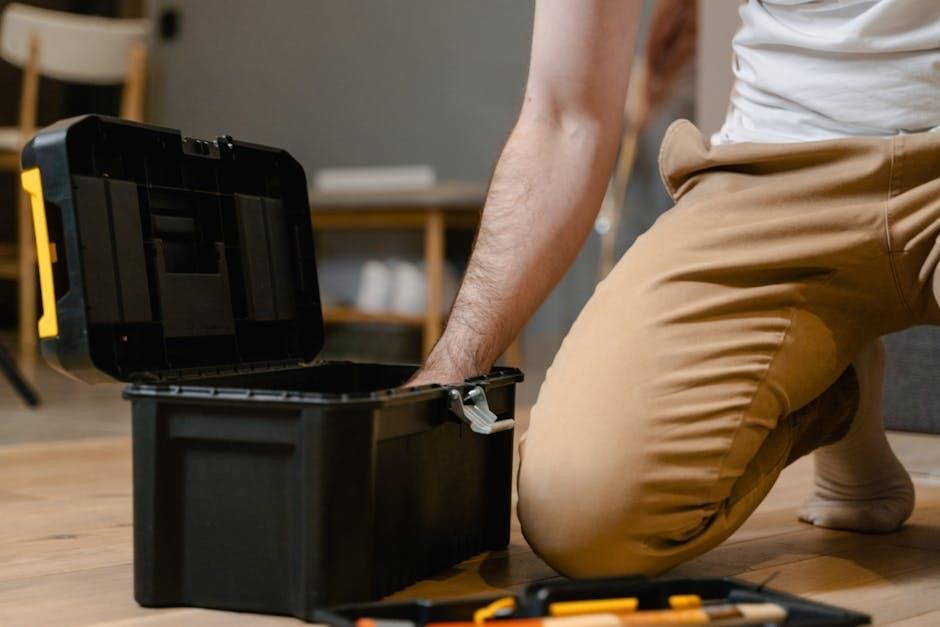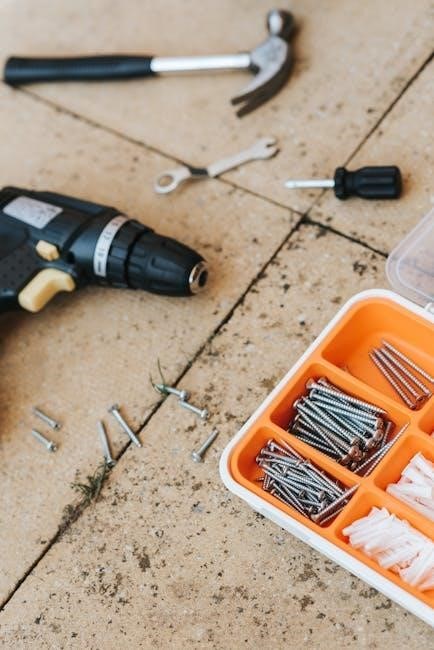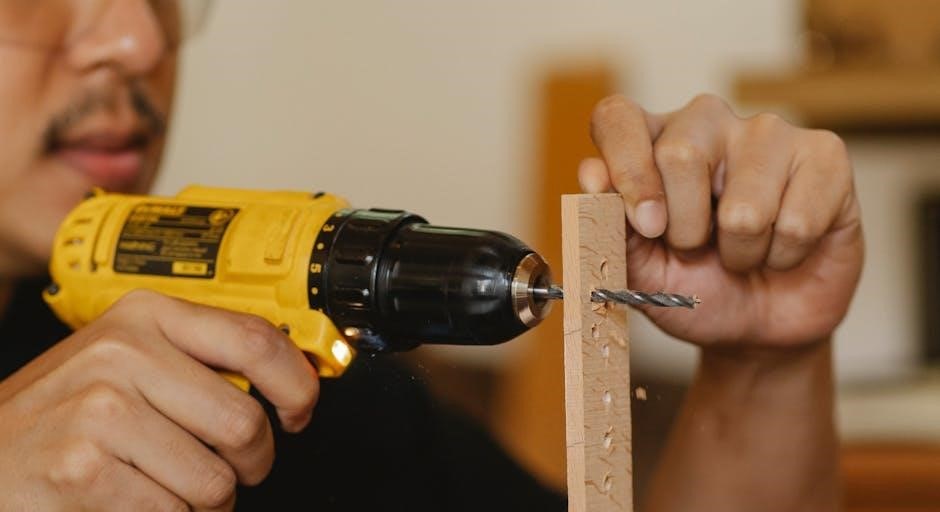
Welcome to the GoGo Scooter Repair Manual, your comprehensive guide for maintaining and repairing your mobility scooter. This manual provides essential tips, troubleshooting, and repair instructions to keep your scooter running smoothly and safely. Whether you’re addressing mechanical issues, electrical problems, or routine maintenance, this guide will help you regain confidence in your scooter’s performance. Follow the step-by-step instructions to ensure your scooter remains reliable and functional for years to come.
Importance of a Repair Manual for GoGo Scooters
A repair manual is essential for GoGo scooter owners, providing detailed guidance for maintenance, troubleshooting, and repairs. It empowers users to address issues independently, saving time and money. With a manual, you can identify problems early, preventing minor issues from becoming major repairs. It also ensures safety by outlining proper procedures, reducing the risk of accidents or further damage. Regular maintenance, as guided by the manual, extends the scooter’s lifespan and optimizes performance. Whether you’re fixing a faulty battery, adjusting brakes, or replacing tires, the manual serves as a valuable resource. It’s a must-have for anyone seeking to understand and care for their GoGo scooter effectively, ensuring reliability and longevity. By following the manual, you can maintain your scooter’s condition and enjoy uninterrupted mobility.
Essential Tools and Equipment Needed for Repairs
Having the right tools and equipment is crucial for effective GoGo scooter repairs. Basic tools include screwdrivers, wrenches, pliers, and Allen keys for disassembling components. A multimeter is essential for diagnosing electrical issues, while a torque wrench ensures proper tightening of bolts and nuts. Safety gear like gloves and goggles protects you during repairs. A workstand or hydraulic lift can help stabilize the scooter, especially for complex tasks. Cleaning supplies, such as brake cleaners and lubricants, are necessary for maintaining moving parts. Additionally, diagnostic tools like a battery tester and wiring diagram can simplify troubleshooting. Always refer to the manual for specific tool recommendations. Having these tools ready ensures you can address repairs efficiently and safely, avoiding further damage to your scooter.

Safety Precautions When Repairing Your GoGo Scooter
Always disconnect the battery before starting repairs to avoid electrical hazards. Wear protective gear like gloves and goggles. Ensure the scooter is stable and secure. Follow all safety guidelines to prevent accidents and ensure a safe repair process.
General Safety Tips for Scooter Maintenance
Before starting any repair, ensure the scooter is turned off and the battery is disconnected to prevent accidental startups. Always wear protective gear, such as gloves and safety goggles, to safeguard against potential hazards. Use a scooter lift or jack to elevate the scooter securely, ensuring it remains stable during maintenance. Keep loose clothing and long hair tied back to avoid entanglement in moving parts. Work in a well-lit, ventilated area to maintain visibility and safety. Never smoke or use open flames near the scooter, especially when handling batteries or electrical components. If unsure about a procedure, consult the manual or seek professional assistance. Regularly inspect tools and equipment for damage to ensure reliability. By following these guidelines, you can minimize risks and ensure a safe repair process.
Specific Safety Precautions for Electrical and Battery Systems
When working with electrical components, disconnect the battery first to avoid electric shocks or short circuits. Use insulated tools to handle wiring and connectors to prevent accidental contact with live circuits. Never touch electrical components with bare hands, as moisture can conduct electricity. If a component is damaged or worn, replace it immediately rather than risking a temporary fix. Avoid overcharging batteries, as this can lead to overheating and potential fire hazards. Always follow the manufacturer’s guidelines for charging and maintaining the battery. When testing electrical systems, use a multimeter to check voltage and current safely. Keep flammable materials away from the work area when handling batteries. Properly dispose of old batteries according to local regulations. By adhering to these precautions, you can safely manage electrical and battery-related repairs for your GoGo scooter.

Diagnosing Common Issues with Your GoGo Scooter
Identify common problems like mobility issues, power malfunctions, or control system faults. Use diagnostic tools and the manual to pinpoint causes and resolve them effectively for optimal performance.
Identifying Mobility Issues
Mobility issues with your GoGo scooter can arise from various factors, such as worn tires, misaligned wheels, or faulty brakes. Start by checking for visible signs like uneven tire wear or loose components. If the scooter struggles to move straight or hesitates during acceleration, it may indicate a problem with the throttle or drive system. Listen for unusual noises, such as grinding or clicking sounds, which could signal worn gears or bearings. Additionally, vibrations during operation may point to unbalanced wheels or a misaligned frame. To diagnose further, test the scooter on a flat, smooth surface to isolate the issue. If the problem persists, consult the repair manual or contact a professional for assistance. Regular inspections and timely repairs are crucial to ensure smooth and safe operation.
Diagnosing Power and Battery-Related Problems
Diagnosing power and battery-related issues in your GoGo scooter is crucial for maintaining optimal performance. Start by checking if the scooter turns on; if it doesn’t, ensure the battery is fully charged and properly connected. Verify the power button and electrical connections for any signs of damage or corrosion. If the scooter operates intermittently, inspect the wiring and connectors for loose or faulty connections. Measure the battery voltage using a multimeter to ensure it matches the manufacturer’s specifications. Additionally, check the charging port and cable for damage or blockages. If the scooter struggles to hold a charge, the battery may need replacement. Always refer to your manual for specific guidelines, and if unsure, consult a professional. Regular maintenance and inspections can help prevent power and battery issues, ensuring your scooter remains reliable and functional.
Troubleshooting Control and Steering Malfunctions
Troubleshooting control and steering issues in your GoGo scooter is essential for safe and efficient operation. Start by checking the throttle and brake levers for proper function. If the scooter responds sluggishly or intermittently, inspect the wiring and connections for damage or corrosion. Ensure the joystick or tiller is aligned correctly and free from obstructions. Test the directional controls to confirm they are functioning as intended. If the scooter veers off course, check the alignment of the front wheels and adjust if necessary. Consult the manual for specific instructions on recalibrating the steering system. If problems persist, consider replacing faulty sensors or seeking professional assistance. Regular maintenance and inspections can help prevent control and steering malfunctions, ensuring smooth and precise handling of your scooter.

Maintenance and Routine Checks
Regular maintenance is crucial for extending the lifespan and performance of your GoGo scooter. Follow a recommended schedule to inspect tires, brakes, and batteries. Clean and lubricate moving parts to ensure smooth operation. Perform routine safety checks before each use to identify potential issues early. Addressing minor problems promptly prevents major repairs. Keep your scooter in optimal condition with consistent care and attention.
Recommended Maintenance Schedule for GoGo Scooters
To ensure your GoGo scooter operates efficiently, follow a structured maintenance schedule. Perform daily checks on tires, brakes, lights, and battery levels before use. Weekly, inspect the frame for damage, tighten loose bolts, and clean the battery terminals. Charge the battery fully once a week, even if unused. Monthly, check the motor, controller, and solenoid for wear or damage. Lubricate moving parts like the steering column and axles. Every 3-6 months, inspect the wiring harness and connections for signs of wear. Replace the battery every 2-3 years or as recommended by the manufacturer. Seasonally, adjust tire pressure and check for proper alignment. Store the scooter in a dry, cool place during winter to protect the battery. A consistent maintenance routine will extend the lifespan of your scooter and ensure reliability. Always refer to the manual for specific guidelines tailored to your model.
How to Perform a Routine Safety Check
Performing a routine safety check on your GoGo scooter is essential to ensure safe and reliable operation. Start by inspecting the tires for proper inflation and signs of wear. Check the brakes for responsiveness and adjust if necessary; Test the lights and indicators to ensure they function correctly. Inspect the battery level and charge it if needed. Examine the frame and seat for damage or loose bolts. Clean any debris from the wheels and axles. Test the throttle and steering for smooth operation. Finally, take the scooter for a short test ride on a flat surface to ensure all systems work properly. Regular safety checks help prevent potential issues and ensure your scooter remains in optimal condition for safe use. Consistency in these checks will keep you confident and secure while riding.
Cleaning and Lubricating Moving Parts
Cleaning and lubricating the moving parts of your GoGo scooter is crucial for maintaining its performance and longevity. Begin by identifying key components such as wheels, axles, and hinges. Use a mild soap solution to clean these parts, avoiding harsh chemicals. For lubrication, apply a silicone-based spray, which is effective and lasts longer. Ensure the lubricant is compatible with your scooter’s materials. The frequency of cleaning and lubrication depends on usage and environmental conditions. Consult the manual or manufacturer’s website for specific recommendations. Safety is paramount; disconnect the battery before starting. Avoid over-lubrication and using incorrect products. Follow tutorials or videos for guidance, and ensure all parts are correctly reassembled post-maintenance. Regular attention will keep your scooter running smoothly and prevent potential issues.

Understanding the Electrical System of Your GoGo Scooter
Understanding your GoGo scooter’s electrical system is key to effective maintenance and repairs. Familiarize yourself with components like the battery, motor, and control systems for improved safety and performance.
Overview of the Scooter’s Electrical Components
Your GoGo scooter’s electrical system is a critical part of its operation, comprising essential components like the battery, motor, control module, and wiring harness. The battery powers the scooter, while the motor converts electrical energy into motion. The control module acts as the brain, regulating speed, braking, and other functions. Proper understanding of these components is vital for troubleshooting and maintenance. Regularly inspect the wiring for damage or corrosion, as this can lead to performance issues. Always follow safety precautions when working with electrical systems, such as disconnecting the battery before repairs. Familiarizing yourself with these components will help you identify and address problems efficiently, ensuring your scooter runs smoothly and safely. Remember to consult your manual or a professional for complex electrical repairs to avoid further damage or safety risks.
How to Diagnose and Repair Faulty Wiring
Diagnosing and repairing faulty wiring in your GoGo scooter requires careful inspection and attention to detail. Start by disconnecting the battery to ensure safety. Use a multimeter to test for continuity and voltage drops in key wiring circuits. Look for signs of damage, such as frayed cables, corrosion, or loose connections. Common issues include faulty throttle or brake switches, worn-out connectors, or short circuits. For repairs, replace damaged wires with equivalent gauge replacements and secure them properly. Apply dielectric grease to connectors to prevent corrosion. If you find a short circuit, trace the wiring diagram to identify the source and isolate the affected area. Always refer to your scooter’s wiring diagram for accurate diagnostics. If unsure, consult a professional to avoid further damage or safety risks. Regular maintenance can help prevent wiring issues and ensure reliable scooter operation.
Replacing the Battery and Charging System
Replacing the battery and charging system in your GoGo scooter is essential for ensuring reliable power and performance. Start by preparing the scooter: disconnect the battery and ensure it is fully discharged. Remove the old battery by unplugging the connectors and lifting it out carefully. Install the new battery, making sure it is securely fastened and connected properly. Reconnect the terminals, ensuring they are tight and free from corrosion. Next, inspect the charging system. Check the charging port for damage or debris and clean it if necessary. Test the charger by plugging it into a power source and verifying the charging indicators. Use a multimeter to confirm the battery voltage matches the scooter’s specifications. If the charging system fails to function, replace the charger or consult a professional. Regularly maintaining the battery and charging system will extend your scooter’s lifespan and ensure consistent operation.

Repairing Mechanical Components
Repairing mechanical components of your GoGo scooter involves addressing issues with the throttle, brake system, tires, and frame. Regular inspection and lubrication ensure smooth operation and longevity.

Fixing a Broken Throttle or Brake System
Fixing a broken throttle or brake system on your GoGo scooter requires careful diagnosis and repair. Start by inspecting the throttle cable for frays or breaks and the brake pads for wear. Clean or replace the throttle potentiometer if it’s malfunctioning, as dirt or corrosion can disrupt signal transmission. For brake issues, check the brake lever and caliper for proper alignment and adjust or replace worn brake pads. Lubricate moving parts to ensure smooth operation. If the problem persists, consult the manual for specific torque settings and safety precautions. Always test the throttle and brakes after repairs to ensure proper function before riding. Regular maintenance can prevent these issues, but prompt repair is essential for safety and reliability.
Replacing Worn-Out Tires and Wheels
Replacing worn-out tires and wheels on your GoGo scooter is essential for maintaining safety and performance. Begin by gathering the necessary tools, such as a lug wrench and new tires compatible with your scooter model. Ensure the scooter is on a level surface and the power is turned off. Remove the wheel covers and loosen the nuts or bolts holding the wheel in place. Carefully lift the scooter to remove the old wheel and replace it with the new one, ensuring proper alignment. Tighten the nuts or bolts securely in a star pattern to maintain even pressure. Finally, test the scooter to ensure smooth operation and stability. Regularly inspecting and replacing tires and wheels will enhance your riding experience and prevent potential hazards.
Adjusting or Replacing the Scooter’s Frame
Adjusting or replacing the scooter’s frame is a critical task that requires precision and care. Start by ensuring the scooter is on a level surface and powered off. Wear protective gloves and eyewear for safety. If adjusting, loosen the frame bolts slightly and use a leveling tool to ensure proper alignment. Tighten the bolts firmly in a star pattern to maintain structural integrity. If the frame is damaged or bent, replacement is necessary. Use a wrench to remove the old frame and install the new one, ensuring all bolts are securely tightened. Inspect the frame regularly for signs of wear or damage, as a compromised frame can affect stability and safety. If unsure, consult a professional technician to avoid further damage or safety risks. Always test the scooter after adjustments or replacements to ensure proper functionality.

Troubleshooting Common Scooter Problems
Identify and resolve common issues with your GoGo scooter by understanding error messages, malfunctioning parts, and performance irregularities. This section guides you through diagnosing and addressing problems effectively, ensuring your scooter runs smoothly and safely. By following these steps, you can identify the root cause of issues and implement the right solutions, minimizing downtime and maintaining optimal performance. Regular troubleshooting can prevent minor problems from becoming major repairs, keeping your scooter reliable for years to come.
Why Your Scooter Won’t Turn On
If your GoGo scooter refuses to turn on, it could indicate a variety of issues. Start by checking the battery level and ensuring it is fully charged. A faulty battery or loose connections to the charger may prevent the scooter from powering up. Next, inspect the power button or key switch for damage or corrosion. Verify that all electrical components, such as fuses or circuit breakers, are intact and functioning properly. Wiring issues, such as frayed cables or poor connections, can also disrupt power supply. Additionally, check for error messages or indicator lights that may provide clues about the problem. If these steps don’t resolve the issue, consult the manual or contact a professional technician for further assistance. Identifying the root cause is essential to restoring your scooter’s functionality.
Solving Issues with Speed or Acceleration
If your GoGo scooter is experiencing issues with speed or acceleration, there are several potential causes to investigate. First, check the battery level and ensure it is fully charged, as a low battery can significantly reduce performance. Next, examine the motor for any signs of wear or damage, as a malfunctioning motor can hinder speed. Clean or replace the motor brushes if necessary. Additionally, inspect the tires for proper inflation and wear, as underinflated or worn tires can affect acceleration. Check the throttle system for smooth operation; a sticky or faulty throttle may need adjustment or replacement. Finally, ensure all electrical connections are secure, as loose wires can disrupt power delivery. If the issue persists, consult the manual or contact a professional technician for further diagnosis and repair. Addressing these areas should help restore your scooter’s speed and acceleration. Regular maintenance can prevent such issues from arising in the future.
Addressing Unusual Noises or Vibrations
Unusual noises or vibrations in your GoGo scooter can be alarming and may indicate underlying issues that need attention. Start by identifying the source of the noise. Common culprits include worn or loose parts, such as wheel bearings, brakes, or suspension components. Inspect the wheels and axles for debris or misalignment, and tighten any loose bolts or screws. If the noise persists, check the motor for wear or damage. A malfunctioning motor can produce grinding or humming sounds. Additionally, ensure proper lubrication of moving parts, as lack of grease can cause friction and noise. If vibrations are excessive, balance the tires or replace them if worn unevenly. Always refer to your manual for specific torque settings and lubrication recommendations. Addressing these issues promptly will help maintain your scooter’s performance and extend its lifespan. Regular inspections can prevent unexpected problems and ensure a smoother ride.

Battery and Charging System Repairs
Learn to diagnose and fix issues with your GoGo scooter’s battery and charging system. This section covers testing, replacing batteries, and troubleshooting charging problems to ensure optimal performance.
How to Test and Replace a Faulty Battery
Testing and replacing a faulty battery in your GoGo scooter is essential for maintaining optimal performance. Begin by ensuring the scooter is turned off and the key is removed for safety. Use a multimeter to measure the battery voltage; a fully charged battery should read around 12.6 volts. If the voltage is significantly lower, the battery may need replacement. Before replacing, charge the battery fully and test it again to confirm the issue. To replace the battery, disconnect the negative terminal first, followed by the positive terminal, to prevent electrical shocks. Install the new battery, ensuring the terminals are securely connected. Finally, charge the new battery according to the manufacturer’s instructions and test the scooter to ensure proper function. Regular battery maintenance can extend its lifespan and prevent unexpected breakdowns.
Troubleshooting the Charging Port and Cable
Troubleshooting the charging port and cable on your GoGo scooter is crucial for resolving charging issues. Start by inspecting the charging port for dirt, corrosion, or damage. Clean the port gently with a soft cloth or compressed air to remove any debris. Next, examine the charging cable for frays, cuts, or bent plugs. If damage is found, replace the cable immediately. Ensure the cable is securely connected to both the scooter and the charger. If the issue persists, test the cable on another scooter or use a multimeter to check for electrical continuity. Also, verify that the charger is functioning properly by testing it with a known good battery. If the problem remains unresolved, consult a professional technician to diagnose and repair any internal charging system faults. Regular maintenance of the charging port and cable can prevent future issues and ensure reliable charging performance.
Understanding Battery Life and Optimization
Understanding battery life and optimization is key to extending the lifespan of your GoGo scooter’s battery. Proper charging habits, such as avoiding overcharging and ensuring the battery is charged when not in use for extended periods, can significantly impact longevity. It’s important to avoid deep discharges, as frequent complete drainage can reduce the battery’s capacity over time. Regular maintenance, like cleaning terminals and ensuring secure connections, also plays a role. Additionally, storing the scooter in a cool, dry place when not in use helps preserve battery health. Monitoring charging cycles and replacing the battery when necessary ensures optimal performance. By following these guidelines, you can maximize your scooter’s battery life and maintain reliable operation. Always refer to the manufacturer’s recommendations for charging and maintenance to get the most out of your GoGo scooter’s battery.

Disassembly and Reassembly of Your GoGo Scooter
This section guides you through the process of disassembling and reassembling your GoGo scooter, using essential tools and following clear steps for effective repairs and upgrades.
Step-by-Step Guide to Disassembling the Scooter
Disassembling your GoGo scooter requires careful planning and the right tools. Start by removing the seat and any accessories to access the main frame. Disconnect the battery to ensure safety. Use an Allen wrench to remove bolts and screws, taking care to label wires for easy reconnection. Remove the wheels by loosening the nuts with a wrench, then lift the scooter to take them off. Next, remove the body panels using a screwdriver, starting with the front and rear covers. Document each step with photos to aid reassembly. Work in a well-lit area, wear gloves, and consult online guides if needed. Remember to keep all parts organized to ensure a smooth reassembly process. This methodical approach will help you navigate the disassembly efficiently and safely.
Reassembling Your Scooter After Repairs
Reassembling your GoGo scooter after repairs requires attention to detail and patience. Start by referencing the photos taken during disassembly to ensure proper alignment of parts. Reattach the wheels, tightening the nuts securely with a wrench. Replace the body panels, ensuring they fit snugly and are screwed in place with the correct torque. Reconnect the electrical components, such as the wiring harness and battery, taking care to match the correct terminals. Reinstall the seat and accessories, making sure they are securely fastened. Once all parts are in place, test the scooter’s functionality by turning it on and checking the brakes, throttle, and steering. If any issues arise, consult the repair manual or seek professional assistance. Proper reassembly ensures your scooter operates safely and efficiently.